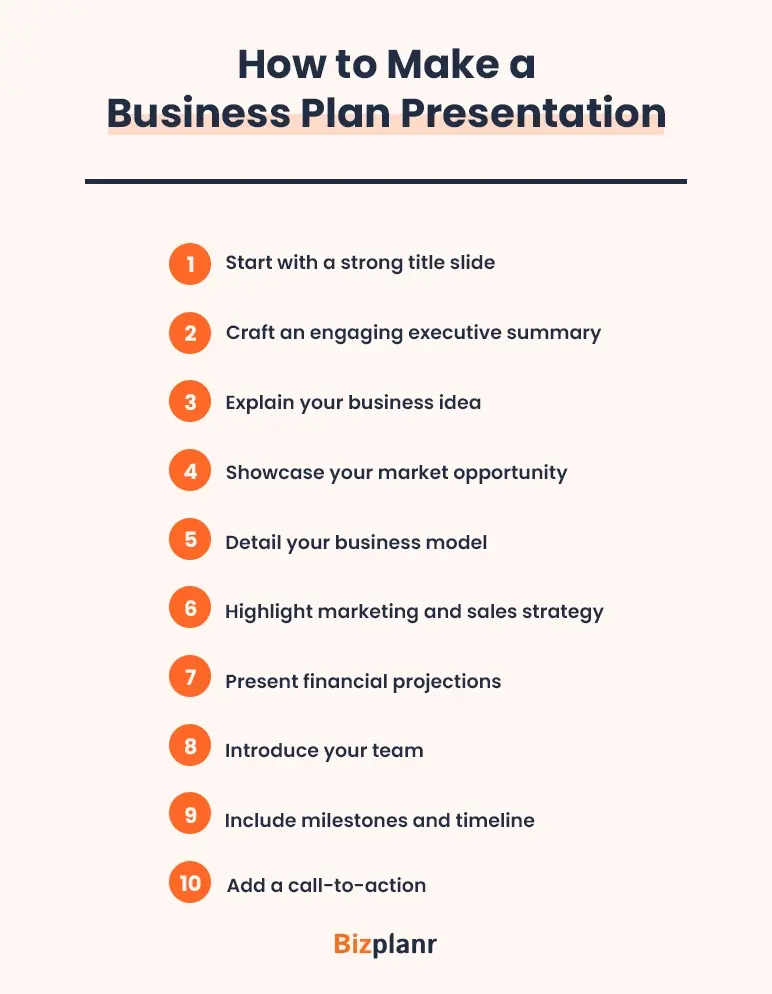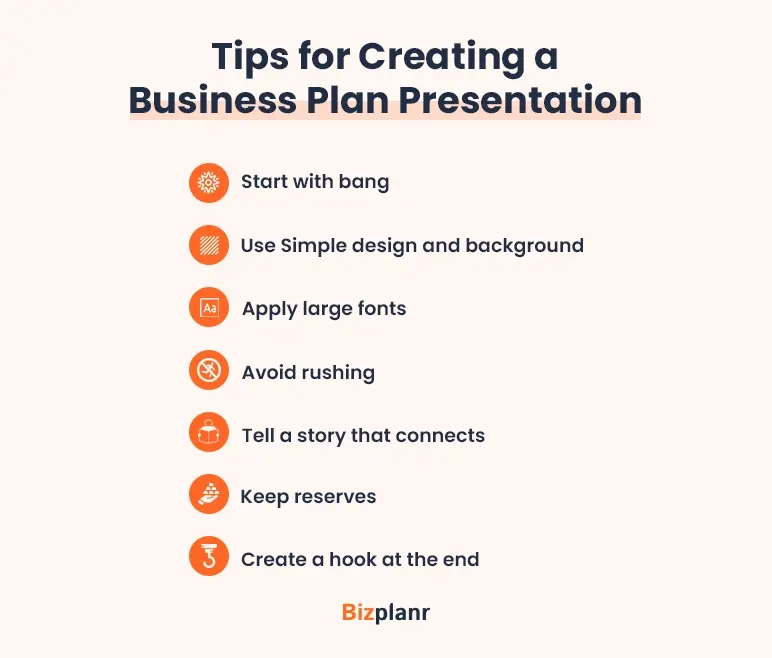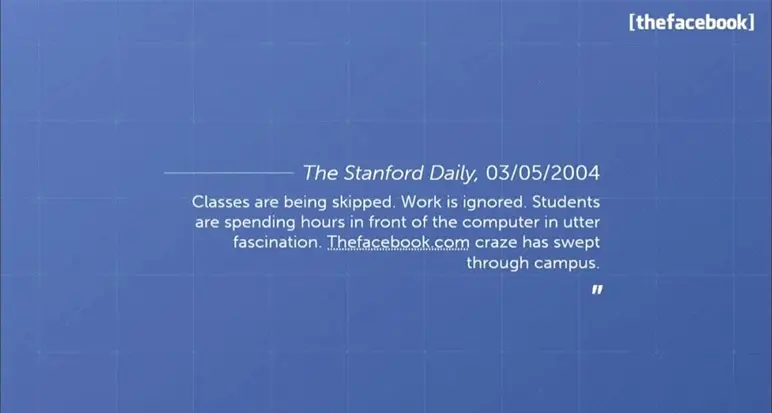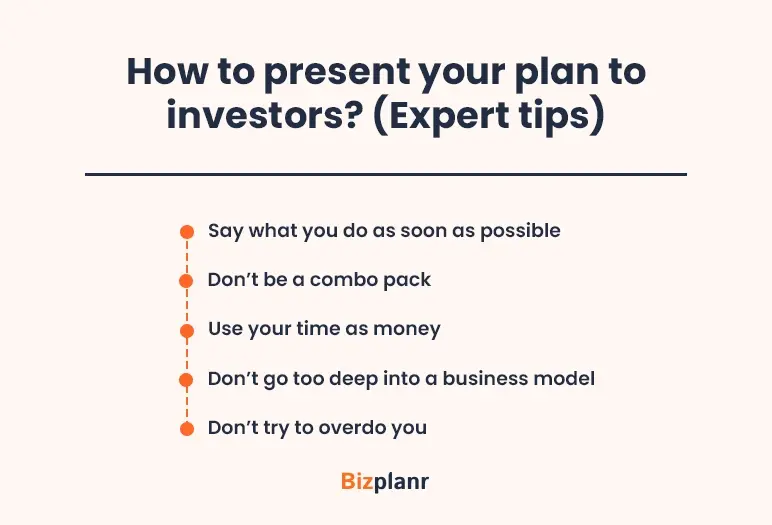Did you know that 81% of consumers have tried a new product simply because its packaging caught their eye?
You might be thinking, "What does packaging have to do with a business plan presentation?" Well, hold on! You're in the right place.
Just like a product's packaging is crucial in grabbing consumer attention, your business plan presentation is equally important in attracting investors.
So, how do you present it effectively? What should you include to make it stand out?
Let's dive in and explore all the secrets to crafting an impressive business plan presentation!
What is a business plan presentation?
A business plan presentation is a structured visual representation of your business plan, often called a “pitch deck”.
It’s designed to effectively communicate your business idea, strategy, and financial projections to a specific audience, such as investors, lenders, or stakeholders. A business plan presentation aims to convey your plan quickly, as visuals are processed in ¼ seconds compared to 6 seconds for words.
Importantly, a well-structured business presentation answers the following questions for its audience:
- What’s your business about?
- Who is your target audience?
- What challenges do your product/services solve?
- How does your business operate?
- What’s your ask?
A business plan presentation & pitch deck are the same
A common misconception is that a business plan presentation differs from a pitch deck.
There's actually no real distinction. The confusion arises because the terms are used interchangeably.
Both serve the same purpose: Visually presenting a business's vision, strategy, and financial projections, allowing the audience to grasp the plan quickly.
What's the purpose of your pitch deck?
To know the purpose of your pitch deck, answer these questions quickly:
- Do you want your audience to understand your business easily and quickly?
- Do you want to impress your audience with your creative works and business strategy?
- Do you aim to inspire confidence and trust in your audience?
- Do you want your idea to stick in their minds even after the meeting ends?
If your answer to these four questions is "yes," you already understand your pitch deck's purpose.
It's designed to simplify complex elements of your business plan, such as target market, market research data, financial projections, and pricing strategy, making them easy to understand and remember.
How to make a business plan presentation
Typically, a business plan presentation is ideal if it fits within 15-16 slides, keeping it concise and engaging.
That said, let’s explore how to structure the content and which essential elements to include to keep the audience connected.
1) Start with a strong title slide
| No. of slides | 1 |
|---|---|
| What to include | Business name, logo, tagline, and contact information. |
| Quick tip | To make a great first impression, keep it clean and use professional fonts. |
In the first slide (title slide), outline the key components of your business, which will provide a quick overview to your audience. Make sure your company name, logo, and tagline are uncomplicated so they are easy for your audience to remember and identify.
2) Craft an engaging executive summary
| No. of slides | 1-2 |
|---|---|
| What to include | Business overview, mission, vision, and business objectives |
| Quick tip | Focus on highlighting important aspects; keep it brief but impactful. |
It’s a chance to present your business plan concisely through an executive summary. Here, you can provide a brief overview of your entire business plan, giving your audience a preview of what to expect in this business plan presentation.
3) Explain your business idea
| No. of slides | 2-3 |
|---|---|
| What to include | A clear description of your product/services, its value, and uniqueness. |
| Quick tip | Use visuals or mockups to make it relatable. |
Clearly articulate the problem or need in the market that your business addresses. Use statistics or quotes to emphasize their significance. To make the presentation more effective, be quick to give a demo demonstrating stats, use graphs and infographics, and highlight facts in bold.
4) Showcase your market opportunity
| No. of slides | 2-3 |
|---|---|
| What to include | Target market, market trends, potential growth, and competition |
| Quick tip | Include data visualizations to showcase market insights. |
The business opportunity slide is where investors and lenders focus closely. Build their trust using graphs, charts, and diagrams to clearly explain your market size, potential customer base, competitor analysis, and future market trends.
5) Detail your business model
| No. of slides | 1-2 |
|---|---|
| What to include | How your business will make money: pricing strategy, revenue streams, and sales strategy. |
| Quick tip | Highlight your subscription plans, prices, and numbers in different colors to avoid confusion. |
Here, strategically outline your business model, explaining how many services you offer, the pricing, and the duration. If it's a product, specify the quantity, pricing, and how you'll deliver it.
To explain your business model, go section-by-section, explain your product, then pricing, and explain why customers will opt for your product at your given price using images, infographics, and visual designs.
6) Highlight marketing and sales strategy
| No. of slides | 1-2 |
|---|---|
| What to include | Inform marketing channels, sales tactics, and funnels you'll use to reach customers. |
| Quick tip | Be specific about your strategies and consider including a timeline for implementation. |
Briefly explain your marketing plan, detailing how you'll reach customers, which social media platforms you'll use, and your tactics for customer retention. Be specific: for example, if using Facebook or LinkedIn, include images of your homepage, mention your strategy, and show the platform's logo to clarify it.
7) Present financial projections
| No. of slides | 2-4 |
|---|---|
| What to include | Key financials: revenue, expenses, profit margins, break-even point |
| Quick tip | Use tables or graphs to make financial data more digestible. |
Present your financial projection using tables rather than just keeping numbers alone. Add your financial plan table for the next five years, and use graphs to explain your growth plan for the upcoming years. If you’re seeking investment, include your request and the timeframe for returning the amount.
8) Introduce your team
| No. of slides | 1 |
|---|---|
| What to include | Core team members, roles, expertise, and why they're the right fit. |
| Quick tip | Include photos for a personal touch. |
The best way to introduce your team to your stakeholders is through organizational structure. You can use ready-to-use templates to prepare your organization chart, which allows you to enter the employee's name, designation, and photograph.
9) Include milestones and timeline
| No. of slides | 1 |
|---|---|
| What to include | Photographs of awards, certificates, and online reviews, and highlight the timeline to achieve your objective. |
| Quick tip | Use a Gantt chart or timeline graphic for clarity. |
Include the milestones you’ve already achieved, but also focus on the ones you plan to achieve. Present this with a chart or graph, and highlight in bold fonts the timeline to show when you aim to reach these goals.
10) Add a call-to-action
| No. of slides | 1 |
|---|---|
| What to include | What you need from your audience: funding, advice, partnership, etc. |
| Quick tip | Make this slide powerful by emphasizing the key benefits of supporting your business. |
Summarize the main points and clearly state what you want from your audience. Include a compelling closing statement using infographics that reinforces your confidence in the plan.
So, here’s how to make the best business plan presentation by including key elements mentioned in this section and impress your potential investors and stakeholders.
Simply including key components isn’t enough for a successful business presentation. It must be well-structured and carefully prepared.
So let’s explore some...
Tips for creating a business plan presentation
These tips will guide you on what to include and what to avoid in your business presentation, which will help you craft a successful presentation.
Let’s unfold it!
Start with bang
Start with a strong story that resonates with your audience. It should be attention-grabbing and fulfill the purpose of your business.
Use Simple design and background
Use a clean, minimal design with limited text, focusing on visuals to convey your message. White or off-white backgrounds with black fonts are popular choices for a professional look.
Apply large fonts
Use clear and prominent font styles such as Calibri, Arial, or Saria. Aim for a font size of 14-16 to ensure readability and ease of understanding.
Avoid rushing
Allow your audience to absorb the information on each slide. Explain each slide thoroughly, and ask, "Do you have any questions?" before moving to the next one.
Tell a story that connects
Turn your data into a story that connects emotionally with your audience. For example, instead of stating, "Our app improves productivity by 30%," say, "Picture a busy professional finishing tasks an hour earlier every day—our app makes that efficiency a reality.
Keep reserves
Always keep a backup of your plan in PDF form—it’s a lifesaver in case of technical glitches or emergencies. Additionally, carry a hard copy of your presentation to leave behind with investors or stakeholders.
Create a hook at the end
End with a strong call to action that reinforces your vision and business goals. Don’t conclude abruptly; remind the audience of what you shared at the beginning to leave a lasting impression.
Business plan presentation examples
Let’s examine a few examples of business plan presentations to understand how a pitch deck works and how it impacts your audience’s attention and your potential to get funded:
1) Facebook — A Classic example if you want to raise funds
Today, Facebook stands as a multi-billion-dollar company, but there was a time when it was just a startup seeking investment to expand its reach all over the USA. This pitch deck is an excellent example if you’re looking to raise funds for your existing business.
Company Info
Company Name: Meta (Facebook)
Industry: Social media
Founder: Mark Zuckerberg, Dustin Moskovitz, Chris Hughes, Andrew McCollum, and Eduardo Saverin
Customer: B2B, B2C
Amount raised: $13.8 Billion
Year: 2004
Investors: Peter Thiel (Co-founder of Paypal)
About pitch
When Mark Zuckerberg introduced TheFacebook.com in its pitch, the presentation began with a striking quote:
While starting with a quote isn’t mandatory, the key takeaway is to hit the right chord with your audience from the beginning. This pitch highlighted that the platform had already gained significant traction among students and was now ready for expansion.
The second standout feature of the pitch was the use of concrete numbers. It showcased the existing user base actively engaging with the platform and outlined the immense potential for growth if funding enabled further expansion.
Moreover, the pitch emphasized TheFacebook.com’s ability to target a specific, high-potential niche audience: students, colleges, and libraries. This unique focus opened the doors for companies looking to advertise directly to this demographic, making the platform an attractive investment opportunity.
The takeaway? A strong business plan presentation combines impactful storytelling, solid data, and clear growth potential to capture the stakeholders’ attention.
2) Uber – For startups and entrepreneur
The Uber example fits perfectly, especially if you’re a startup solving a specific problem. In this business pitch, see how Uber identified a problem, turned it into its cornerstone, and provided a solution that has now redefined taxi booking across the USA, Europe, and other countries.
Company info:
Company Name: UberCab
Industry: Transportation
Founder: Travis Kalanick, Garrett Camp
Customer: B2B, B2C
Amount raised: $200K
Year: 2008
Investors: Angel investor
In Uber’s opening slide, they highlighted a pain point that resonated with the everyday struggles of people in the USA: the inconvenience of traditional taxi booking.
Uber disrupted this by introducing the UberCab app, allowing users to book a cab from their homes conveniently. While your startup doesn't need to have the same pain point or follow an identical approach, you can create an attention-grabbing narrative that keeps your audience engaged.
The key takeaway is how Uber identified a niche market, disrupted a monopolized industry, and showcased scalability with a clear vision and user-focused innovation.
Their concise presentation is a masterclass in identifying pain points and delivering impactful, solution-driven messaging.
How to present your plan to investors? (Expert tips)
I once read an essay from Paul Graham, VC investor and Y Combinator founder on presenting to investors, and it just stuck with me. Sharing some of my favourite tips from that essay.
1) Say what you do as soon as possible
This applies to all businesses, but especially to startups, as investors tend to judge them quickly. Instead of letting them judge your product, focus on sharing what you do.
For example, "Hi I'm Mark; I have built an easy-to-use application that tracks users' health. Now, I'll show you how it works and how it helps our users." This approach will make them more interested and less likely to judge hastily.
2) Don’t be a combo pack
This means you shouldn't be the one controlling the computer and delivering the explanation simultaneously! Instead, focus on maintaining eye contact with the audience and confidently delivering your explanation. Have someone else manage the slides for you.
This approach will strengthen your connection with the audience, allowing you to communicate more effectively. You won’t have to build up the presentation constantly; you can stay engaged and focused on your message.
3) Use your time as money
Your business aim, mission statement, and objectives should be presented early in your presentation. If you're short on time, cover these key points first. Competitor analysis, team member resumes, and risk analysis can be covered in 15-30 seconds per slide, which won’t cause any issues.
The most important is communicating your objectives, mission, and why you're pursuing this business. These elements should be given more time to ensure the audience fully understands your vision and purpose.
4) Don’t go too deep into a business model
Explaining your business model is crucial, as your stakeholders need to understand how you operate. However, diving too deep into the details as attention spans during a pitch are low and you want to avoid information overload. It could distract them from your core message.
So keep it concise—just inform your revenue plans, pricing strategy, and how you’ll scale.
5) Don’t try to overdo you
Don’t worry if you’re a startup and your founders are new to the field or lack technical or business experience. Today’s investors don’t expect your business plan to be flawless, highly polished, or technically perfect.
They care about your ability to handle future risks and how quickly you’re able to solve issues without panicking. Entrepreneurs look for such potential. If your idea has that unique edge, even with a small team, investors will be interested in backing you.
Wrapping up
We hope you found this blog helpful and that it empowers you to create and deliver impactful presentations. Throughout this post, we've explored the purpose of a pitch deck and how to craft a business plan presentation using examples, tips, and key strategies.
Crafting a business plan presentation can be time-consuming and require significant effort, but in today’s digital age, there's an easy alternative—AI.
AI tools like Bizplanr make creating compelling business plans and investor-ready presentations faster and easier. All you need to do is answer a few simple questions and see your deck coming through.
So what are you waiting for? Try it out today and craft a successful presentation!
Get Your Business Plan Ready In Minutes
Answer a few questions, and AI will generate a detailed business plan.
Frequently Asked Questions
What are the best tools for developing a business plan presentation?
The best tools for creating a business plan presentation include PowerPoint, Google Slides, Upmetrics, and Canva. These tools provide user-friendly templates, customizable design features, and the ability to easily integrate visuals like charts and graphs, helping you present your business plan in a professional, clear format.
How long should a business plan presentation be?
A business plan presentation should typically be 15-20 slides long. This allows you to cover all key aspects of your business without overwhelming your audience.
What to include in your business plan presentation?
Your business plan presentation should include an executive summary, company overview, business idea, market analysis, sales forecasts, pricing model, marketing plan, financial projections, and team introduction.
How to present a business plan to investors?
When presenting a business plan to investors, focus on clarity and confidence. Start with a compelling executive summary, followed by essential details like the market opportunity, your unique value proposition, and financial projections.









